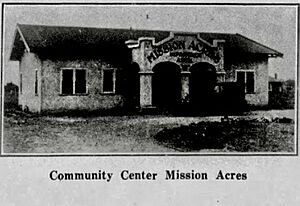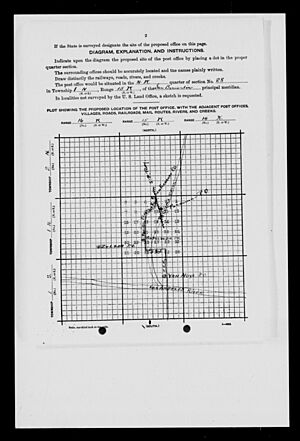Mission Acres, California facts for kids
Mission Acres was a small farming community located in the northern San Fernando Valley in California. Today, this area is mostly known as North Hills and Sepulveda, within the city of Los Angeles. Its western edge was near Bull Creek, a stream flowing from the mountains.
Contents
History of Mission Acres
Early Days and Land Sales
Long ago, in the 1800s, this land was part of the Mission San Fernando Rey de España. Later, it became part of a large ranch owned by Andrés Pico.
In the early 1900s, it became easier to reach Mission Acres. The Pacific Electric Red Car train line, called the San Fernando Line, connected it to Downtown Los Angeles. This made it easier for people to travel to the farms and towns in the San Fernando Valley.
In 1914, a company called Patton & Longley started advertising land for sale in an area they called Mission Acres. Another company, Angeles Mesa Land Company, then took over the sales. They divided about 80 acres into smaller plots. The rest of their land, about 3,000 acres, was set up for farming, especially for growing citrus fruits like oranges and lemons.
Growing the Community
The first land sales for Mission Acres began on March 4, 1915. To help people learn how to farm, the company offered free classes. Experts taught buyers about raising chickens, pigeons, rabbits, and how to grow many crops on small plots of land. The land was advertised as having "one of the richest soils" near Los Angeles.
Many important people already owned farms in the area. Frank Wiggins, from the Los Angeles Chamber of Commerce, had a 20-acre orange grove. Stoddard Jess, a bank vice president, owned a 40-acre lemon grove.
Land was sold for $495 per acre, with a small down payment. Free trips were offered to potential buyers to see the land. The main reasons people wanted to buy here were the rich soil and the new Owens Valley aqueduct. This aqueduct brought plenty of water for irrigation. The area also had good transportation with the new North Sherman Way boulevard and the Pacific Electric Railway. It was also close to the growing towns of San Fernando and Van Nuys. The company even used the land's history with the San Fernando Mission in its ads, calling it "The 'chosen lands' of the mission fathers."
Joining Los Angeles
On March 29, 1915, Mission Acres and most of the San Fernando Valley became part of the City of Los Angeles. This was a big deal for farmers. It meant they could buy extra water from the Owens Valley aqueduct, ensuring they had a lot of water for their crops.
By late 1915, 28 homes had been built. The sales manager reported that over $125,000 worth of land had been sold. The company even set up a "model acre" farm. This farm showed buyers how to use their land to grow food and make a profit. They also tried to encourage businesses by offering money to anyone who built a grocery store right away.
By 1916, about 50 homes were in the area. The Angeles Mesa company started building a store and café that looked like the San Fernando Mission's convent. The Los Angeles Board of Education also decided to buy three acres of land to build a school for Mission Acres.
By 1917, over $1,000,000 worth of land had been sold. The model farm continued to show how an acre of land could support a family and make extra money. It had fruit trees, vegetables, and areas for chickens, pigeons, and rabbits. Mission Acres became known as one of the best places for poultry farming in California.
Residents also built a new club house. A street called Orange Avenue was renamed Betkouski Avenue, but residents didn't like it. They asked to change it again to Burnet Avenue, which is still its name today.
During World War I, a resident named J. T. Matthews faced issues because of his views on the war. Later, in 1919, the women's committee of Mission Acres helped raise money for the "Victory Drive."
Growth in the 1920s
The 1920s brought fast growth to Mission Acres. It began to change from a farming area into a real town. By 1921, Mission Acres had its own grammar school. The Woman's Club of Mission Acres was also active, documenting the history of the valley.
In 1925, the Southern California Gas Company started installing gas pipes to bring natural gas to Mission Acres. Roads were also being paved, including Parthenia Street.
Valley residents, including those from Mission Acres, wanted fair representation in the City Council. They wanted to make sure the valley received needed improvements like flood control, bridges, and better roads. The city council was reformed, and the 1st district, covering the valley, got its first representative, Charles Hiram Randall.
Major road improvements were planned for the San Fernando Valley. Harvey Arthur Van Norman, the city engineer, announced that Saugus Avenue (now Sepulveda Boulevard) would be paved. This road would become a very important route for Mission Acres and the city of San Fernando. The Sepulveda Road was also extended through the Sepulveda Pass, creating a direct route from the Harbor district to the Valley.
Changing the Name to Sepulveda
By March 1925, residents of Mission Acres wanted to change the community's name. They felt "Mission Acres" didn't fit a growing town. The Mission Acres Chamber of Commerce planned to gather signatures to choose a new name.
In 1926, the Mission Acres post office officially opened. More local roads were paved, like Burnet Avenue and Rayen Street. The community also worked with other valley towns to stop the spread of puncture vine, a weed that could flatten car tires.
In 1927, after heavy rains caused flooding, the chambers of commerce in Mission Acres and Van Nuys worked together to plan a drainage system.
The residents of Mission Acres decided to rename the area Sepulveda in 1927. They chose this name because of the new Sepulveda Boulevard that ran through the town. The name change was celebrated with a barbecue. However, some residents were confused because there was another place called Sepulveda between Burbank and Glendale. The Los Angeles Times later explained that the "Sepulveda of today" was the old Mission Acres section.
The area was known for its coast live oaks and California two-petal ash trees. Farmers in Mission Acres grew citrus fruits, raised chickens for eggs, and had whiteface cattle. They also raised California quail, grew vegetables, and cultivated gladioli flowers.
Images for kids




